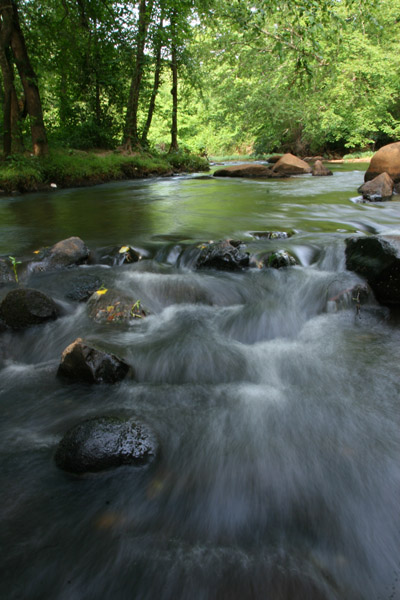 One of my photo students, the (likely) Inconsolable Al Bugg, has been jonesing for a couple of opportunities for a while now. And unfortunately, while he is away counseling at a summer camp, I pursued both of them in just the past couple of days.
One of my photo students, the (likely) Inconsolable Al Bugg, has been jonesing for a couple of opportunities for a while now. And unfortunately, while he is away counseling at a summer camp, I pursued both of them in just the past couple of days.
Tuesday morning I was up ridiculously early and the conditions seemed right, so in the pre-dawn twilight I headed down to the head of the Neuse River, my old stomping grounds. I used to live just a few miles away, about 17 years ago, right as I was getting serious about photography and starting to build up my stock, and it’s a neat little natural area with relatively easy access, so I spent a lot of time down there. Just one image currently resides in the gallery of my main site, right here, while another is in that rotating banner at the top, if you wait long enough (you’ll recognize it.) Mr. Bugg and I had made one attempt last year to get down there and go exploring, but properly exploiting all of the opportunities requires a period with light to average rainfall, something that we didn’t have at the time – instead, we’d had numerous downpours in the past two weeks, and the spillway from Falls Lake that creates the river itself was wide open to handle all the excess from the lake. As a result, the river level was over a meter higher than normal, which (as can be seen from these images) obscures many of the scenic aspects and makes wading impossible. It is partially due to the habits I developed for this area that the “Wading-In” site name was even decided upon.
This week’s trip, however, took place in near-ideal conditions. The water level was low enough for access to a lot of areas, and the temperature perfect – warm enough to barely be noticed, but cool enough to feel great, and the air temperature wasn’t climbing too rapidly either. The main downside was the sky, which was thick haze pushing towards overcast, preventing it from being a useful element in any scenic shots.
To truly appreciate the locale, one must be willing to get wet, and this is where the waterproof sandals are a necessity (and pretty much my main footgear all summer long.) The river bottom is just cluttered enough to make going barefoot dangerous – far too many fucking assholes that cannot discard their beer bottles in a trash bin, not to mention the other junk that accumulates – but even without that there are the mussel shells, in places completely carpeting the river bottom and easily wending their way into the sandals just to be perverse. For some reason – maybe it’s my feet – the sandals seem to be a kind of one-way valve, where the shells can get in readily enough but then somehow cannot find their way out again, no matter how much shaking and swishing my feet around I do. Coupled with the large amount of silicates in the area, ‘sand in the making’ quartz particles eroded from the distant mountains and on their way to the just-as-distant beaches, it’s not hard to get a sandal-full of abrasive junk. But that’s not enough to keep me out of the water by a long shot.
The river immediately splits into two branches straight out of the spillway, and there’s a parking area on one bank; this used to be just a canoe launch before the city of Raleigh revamped it to make it a ‘greenway’ trail for walkers, joggers, and bicyclists. The paved trail avoids all the good areas, though, so one must depart the path in the right places to find the good stuff, and thankfully not too many people even try – I was all alone for my entire visit this time. Cross the shallow river at the right spot and you come across a cut between the two channels, a placid little cove partially shrouded in shade and perfect for vegetating.
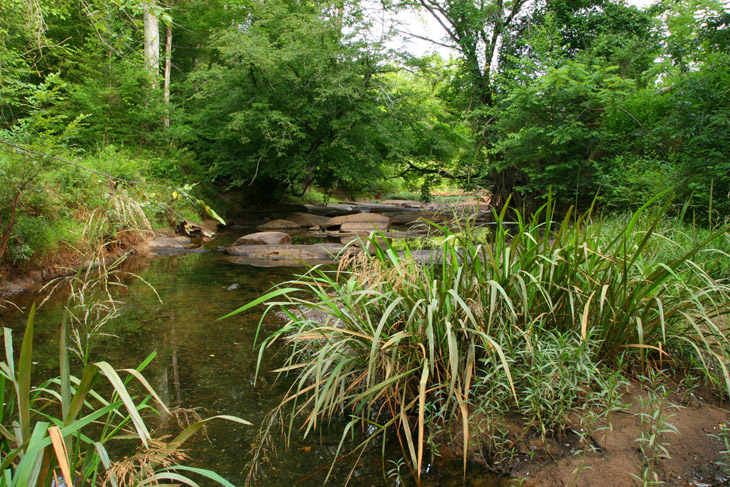
 The other end of the cove opens on the opposite channel of the river, with long narrow rock islands stretching out into the main part of the river. This area is ruled by birds: great blue herons (Ardea herodias) of course, and belted kingfishers occasionally hurtling past with their chittering alarm. A pair of red-shouldered hawks had been constantly venting their slightly anxious-sounding calls from the moment I approached the area, and once I hit the cove I found out why: a mated pair was quite concerned with a murder of crows that could not be convinced to leave the premises despite being aerially harassed by the hawks. I did not have the recorder in hand when one of them buzzed low overhead, else I would have had a great sound bite. My emergence on the second channel sent off the hawks to a greater distance, but this might well have been a good thing, because the crows completely vacated the area when they saw me.
The other end of the cove opens on the opposite channel of the river, with long narrow rock islands stretching out into the main part of the river. This area is ruled by birds: great blue herons (Ardea herodias) of course, and belted kingfishers occasionally hurtling past with their chittering alarm. A pair of red-shouldered hawks had been constantly venting their slightly anxious-sounding calls from the moment I approached the area, and once I hit the cove I found out why: a mated pair was quite concerned with a murder of crows that could not be convinced to leave the premises despite being aerially harassed by the hawks. I did not have the recorder in hand when one of them buzzed low overhead, else I would have had a great sound bite. My emergence on the second channel sent off the hawks to a greater distance, but this might well have been a good thing, because the crows completely vacated the area when they saw me.
The footing can be deceptive in such conditions. The dry parts of the rocks well out of the water mostly have a rough texture and provide about as good traction as can be expected in a natural setting, but below the surface is another matter entirely. Coated with fine weeds and algae and often an additional layer of silt, the rocks become damn near as slippery as wet ice, and stepping on one is simply asking for trouble. This meant that the camera got safely stowed just about every time I stepped anywhere, which meant that when the two herons came cruising up the river only a few meters off the water and turned directly towards me, I couldn’t get the camera out in time, missing what could have been some magnificent closeups while in flight. “Could have been” is of course highly speculative; nailing focus and framing on a moving subject in such a manner is far from guaranteed, but any photographer will usually treat it as the award-winning shot that got away.
Also on hand were some northern rough-winged swallows (Stelgidopteryx serripennis,) the first I’ve ever seen. They were performing elaborate dogfight maneuvers down low over the water, snatching insects from the air. They weren’t terribly bothered by my presence, so when a handful of them took to a nearby perch, I slipped in closer without any trouble and soon realized I was seeing this year’s brood not long out of the nest. The agitated half-flapping motion (as if trying to fan away a fart) every time an adult drew near, coupled with the gaping behavior, was kind of a giveaway.

I did not see a single snake while I was there, which is curious because I virtually always see at least one, sometimes several – it’s an ideal location for the various water snake species. However, when turning around as I was standing near an uprooted tree, I caught the movement of a tail curling down into ‘resting’ position while the owner’s head was hidden from sight behind a branch. Moving slowly with the camera at the ready, I came around to the other side with the intention of snagging a portrait before the reptile fled. As suspected, it was a skink, but my caution wasn’t necessary in the slightest because I was approaching from its blind side.
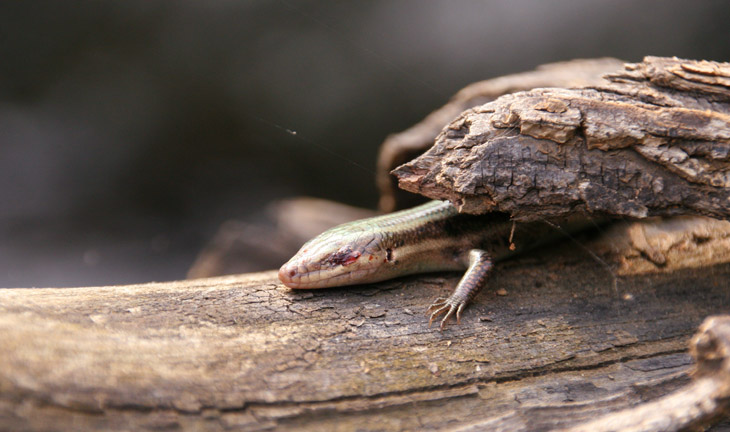
The five-lined skink, an adult female, wasn’t completely unaware of my presence; despite the covering noise of the running water and the breeze, the sound of the camera bag’s zipper caused her to raise her head warily, ready to bolt, but she never turned enough to spot me.
Not too long after that, the battery pack/vertical grip on the camera simply failed, the mounting screw completely pulling out as I was adjusting the camera on the tripod, and luckily it was firmly in hand when it did so because I was knee-deep in the river when this occurred. If you’re familiar with Canon’s accessories, the normal battery door must be removed to fit the grip, and it slots nicely into its own space inside the grip; as this came free, however, the battery door made its escape unnoticed and still sits somewhere in the Neuse River. Which effectively prevented me from using the camera at all, since I couldn’t just insert a battery as normal either. I came home and ordered replacements for both, and resigned myself to not shooting anything for a bit until they arrived, unless I wanted to use the old D-Reb.
That was Tuesday. On Wednesday night/Thursday morning, the muggy weather produced some thunderheads outside of meteorological predictions, and it appeared a nice lightshow was at hand. I grabbed the D-Reb and trotted across to the pond nearby, but on arrival the older camera wasn’t playing nice and refused to operate, and once again I settled for watching the natural fireworks without taking any photos of it (I did shoot a brief video on my flip-phone, but that’s more of a joke than anything.)
The cell passed, but a little later on another took its place, and I thought, “The battery has a locking pin, so maybe it’ll stay in place and operate even without the battery door?” I tried it out, it worked, so I covered the battery opening with a piece of packing tape and went out across the pond again to start shooting.
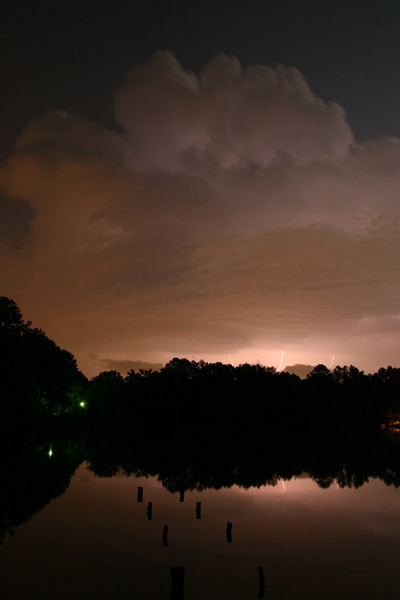 Mr. Bugg has been trying to photograph a decent electrical storm for a while now, and my assurances that this can be really tricky have done little to appease him. Yet it’s perfectly true: getting a decent display, in a good setting with a good view, is more miss than hit, and I’ve gone years without any kind of acceptable shots despite being almost instantly ready for any storm that shows promise. The past couple of years have been extraordinarily lucky for me, both with the frequency of storms and the quick access to several good vantages; in the old house, there were so many obscuring trees around that I had to travel to an open sky area and hope I could find one facing in the direction of the active thunderhead.
Mr. Bugg has been trying to photograph a decent electrical storm for a while now, and my assurances that this can be really tricky have done little to appease him. Yet it’s perfectly true: getting a decent display, in a good setting with a good view, is more miss than hit, and I’ve gone years without any kind of acceptable shots despite being almost instantly ready for any storm that shows promise. The past couple of years have been extraordinarily lucky for me, both with the frequency of storms and the quick access to several good vantages; in the old house, there were so many obscuring trees around that I had to travel to an open sky area and hope I could find one facing in the direction of the active thunderhead.
Even when there’s a decent view (yes, you may have seen this perspective in an earlier post,) that doesn’t mean the storm will cooperate. Inter-cloud activity can provide some light and shaping to the clouds, but that often only looks like moonlight, and of course everyone wants to see the dramatic bolts. On this evening I was actually working in moonlight, the nearly-full moon shining brightly on an isolated large thunderhead. But the lightning was being shy, and when it did appear, it was primarily like this, barely visible underneath the cloud deck, mostly because of the distance of the storm. The light rain had long passed and this cell was many kilometers off, very active but mostly lacking visible bolts. I just kept tripping frames and waited; there wasn’t anywhere else I had to be at freaking three AM (I keep weird hours.)
I’d like to say that patience pays off, but storms can be fickle, and often enough I simply go back without anything even remotely decent to show for it; it occurred earlier this month, in fact, a fierce storm that I did not get home in time to take advantage of, despite the great show while I was driving (sans camera, naturally – I do occasionally go someplace without it.) And then again, sometimes it does.
 I had given up trying to frame a bolt with its own reflection in the water, and had switched orientation to zoom in a little tighter on the active part of the thunderhead, so I missed that composition, but it still looks a lot better than inter-cloud glows. Most of the time when there was a visible bolt, it was a thin thing stretching across the sky in an aimless and lint-like manner, but lightning is known for being unpredictable, and this nice ground strike is a beneficial aspect of that. The cell was near-immortal, tapering off and seeming to be fading before developing a whole new life, all without moving in the frame much at all, appearing to be stalled someplace well east. It was still slightly muggy, but not too uncomfortable, and when things like this happen you tend to ignore that anyway.
I had given up trying to frame a bolt with its own reflection in the water, and had switched orientation to zoom in a little tighter on the active part of the thunderhead, so I missed that composition, but it still looks a lot better than inter-cloud glows. Most of the time when there was a visible bolt, it was a thin thing stretching across the sky in an aimless and lint-like manner, but lightning is known for being unpredictable, and this nice ground strike is a beneficial aspect of that. The cell was near-immortal, tapering off and seeming to be fading before developing a whole new life, all without moving in the frame much at all, appearing to be stalled someplace well east. It was still slightly muggy, but not too uncomfortable, and when things like this happen you tend to ignore that anyway.
And again.
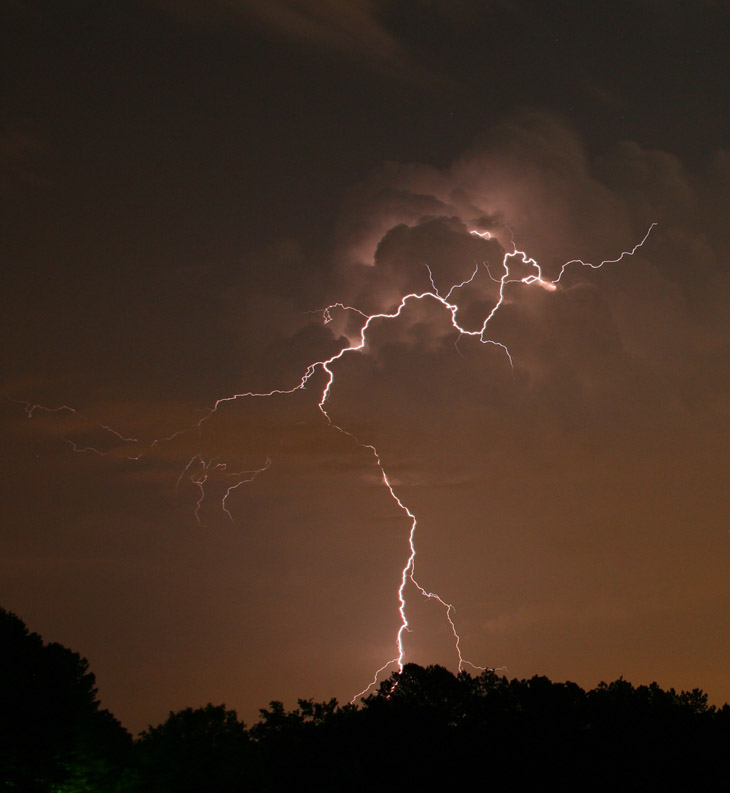
The moon was shining bright enough to limit the duration of the exposures, plus I was aimed directly towards the city center, which was throwing a lot of light onto the lower clouds, some seen here in front of the bolt, that were much closer than the thunderhead itself – that’s where the orangish glow comes from. Someday I’ll get out to the beach, or someplace far out in the western states, to shoot storms without the taint of light pollution, but for now this is what we get.
Even when those low and close clouds thickened enough to nearly obscure the distant thunderhead, storms can surprise you, and when I had packed up and was walking back, another lovely bright bolt blasted through the obscuring humidity just to tell me I was still not patient enough. But I can’t complain about the results all the same – I’ve paid my dues over the years.



















































